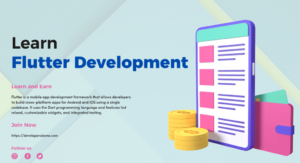Flutter is a popular open-source mobile application development framework that allows developers to create visually appealing, responsive, and scalable user interfaces. One of the essential widgets in Flutter is the Expanded class, which is used to create flexible and responsive layouts. In this blog post, we will explore the Expanded class in detail, its usage, and its benefits in building user interfaces in Flutter.
Contents
What is the Expanded Class in Flutter?
The Expanded class is a flexible layout widget in Flutter that expands to fill the available space in the parent container. It is typically used in combination with other widgets such as Rows, Columns, and Flex widgets to create flexible and responsive layouts.
How does the Expand Class work?
The Expanded widget takes up all the available space in the parent container along the main axis. The main axis is determined by the parent widget. For instance, if the parent widget is a Row, the main axis is horizontal, and if it’s a Column, the main axis is vertical.
When you add an Expanded widget to a Row or Column, it takes up the remaining space along the main axis after other children have been laid out. The Expanded widget then applies its flex factor to the remaining space to determine how much space each Expanded widget should occupy.
What are the benefits of using the Expand Class?
The Expanded class offers several benefits in building user interfaces in Flutter. Some of the benefits include:
- It allows you to create flexible and responsive layouts that adapt to different screen sizes and orientations.
- It helps to distribute space evenly among children in a Row or Column widget.
- It ensures that widgets inside a Row or Column widget are positioned correctly, irrespective of their sizes.
- It makes it easy to create complex layouts that would otherwise be difficult to achieve using other widgets.
How do you use the Expanded Class in Flutter?
To use the Expanded class in Flutter, you need to follow these steps:
- Create a parent widget such as a Row or Column.
- Add children widgets to the parent widget.
- Wrap one or more children widgets with an Expanded widget.
- Set the flex factor for each Expanded widget to determine how much space it should occupy.
Here is an example of using the Expanded class in a Row widget:
Row(
children: <Widget>[
Container(
color: Colors.blue,
height: 50,
width: 50,
),
Expanded(
flex: 1,
child: Container(
color: Colors.red,
height: 50,
),
),
Expanded(
flex: 2,
child: Container(
color: Colors.green,
height: 50,
),
),
],
)
In this example, we have a Row widget with three children. The first child is a blue container with a fixed width and height, and the second and third children are Expanded widgets with flex factors of 1 and 2, respectively. The second child takes up one-third of the remaining space, while the third child takes up two-thirds of the remaining space.
Can you nest Expanded widgets in Flutter?
Yes, you can nest Expanded widgets in Flutter. However, it’s important to note that nesting Expanded widgets can lead to unexpected layout issues. It’s recommended to use other layout widgets such as SizedBox or Spacer to control the spacing between children’s widgets.
Conclusion:
The Expanded class is a powerful widget in Flutter that helps to create flexible and responsive user interfaces. It is commonly used in combination with other layout widgets such as Rows, Columns, and Flex widgets to achieve complex layouts. By understanding how the Expanded class works and its benefits, you can improve the responsiveness and flexibility of your Flutter apps.
In summary, the Expanded class in Flutter is a useful tool for creating flexible and responsive user interfaces. It helps to distribute space evenly among children’s widgets and ensures that widgets are positioned correctly, regardless of their sizes. By using the Expanded widget, you can create complex layouts that adapt to different screen sizes and orientations, making your Flutter apps more user-friendly.
As a final note, it’s important to use Expanded widgets sparingly and avoid nesting them to prevent unexpected layout issues. By following best practices and guidelines, you can leverage the power of the Expanded class in Flutter to create beautiful and responsive user interfaces.
So, go ahead and explore the possibilities of the Expanded class in Flutter, and take your app development skills to the next level!

